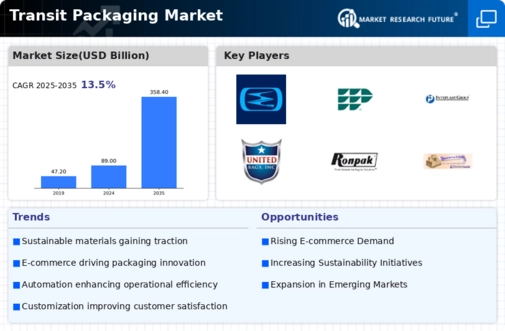Market Analysis
In-depth Analysis of Transit Packaging Market Industry Landscape
The Transit Packaging Market is an ever-changing business sector which plays an essential role in protecting goods during transit. Various factors affect dynamics of this industry causing changes to materials utilized in packages, designs chosen for transportation packages and overall strategies employed. One of the most significant drivers of change is global shift towards green practices. Transit packaging has also witnessed an increase in demand due to growing concern over environmental issues and thus there is need to make such solutions eco-friendly while minimizing carbon footprint through developing innovative package materials and designs that consider recyclability or biodegradability first.
Further still; technology advancements have had very great impacts on transit packaging arena today. Smart-packaging solutions like RFID tags among others enable real-time tracking during movement of goods from one place to another using mobile devices or other systems linked up either manually or automatically. This provides both security for the goods on transit and data that can be used to optimize the supply chain. In addition, application of automation and robotics have made packaging processes more efficient reducing human error as well as improving overall market dynamics.
In the same way, boom in e-commerce has greatly affected transit packaging market. The increase in online shopping means that during multiple handling and transportation stages, there is need for packages able to withstand these challenges. Therefore, there is a growing demand for durable and protective packaging materials that will ensure safe delivery of goods to the ultimate consumer. Also, omni-channel distribution complicates further what was initially a straight forward matter creating need of packaging solutions which are adaptable enough for different channels of distribution.
The transit packaging industry’s regulatory changes as well as international trade agreements also influence its shape considerably. It is of utmost importance to adhere to packing standards and rules by companies involved in cross-border shipments. Packaging materials are supposed to follow specific guidelines so that they provide safe transport of products from one region to another without any problems whatsoever. Changes in trading policies such as tariffs may affect availability and costs attributed with some particular package components thereby affecting how dynamic the markets are at large.
The transit packaging market is fiercely competitive and marked by unflagging changes. Packaging firms are undertaking research to outdo each other in terms of introducing new materials and designs that meet the changing requirements of the industry. Besides, packaging companies are creating more collaborative relationships with logistics corporations as they work towards providing their clients with packages that integrate all facets of the supply chain.
















Leave a Comment